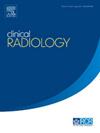A computed tomography (CT)-based ternary classification model for predicting the invasiveness of pure ground-glass nodules
IF 1.9
3区 医学
Q2 RADIOLOGY, NUCLEAR MEDICINE & MEDICAL IMAGING
引用次数: 0
Abstract
OBJECTIVE
To develop and validate a multinomial logistic regression model utilising computed tomography (CT) features for the classification of the invasiveness of pulmonary pure ground-glass nodules (pGGNs).
MATERIALS AND METHODS
This retrospective study involved 1572 pathologically confirmed cases of pGGNs, which included atypical adenomatous hyperplasia (AAH), adenocarcinoma in situ (AIS), minimally invasive adenocarcinoma (MIA), and invasive adenocarcinoma (IAC). These cases were categorised into three groups based on invasiveness: precursor glandular lesions (PGLs, AAH + AIS), MIA, and IAC. The cohort was randomly divided into training (70%), testing (15%), and validation (15%) sets using stratified sampling. Univariate and multivariate analyses were conducted to identify candidate predictors, and L1-regularised (Lasso) feature selection was employed to reduce dimensionality. Subsequently, a multinomial logistic regression model was constructed. The model’s performance was evaluated using the area under the receiver operating characteristic curve (AUC), sensitivity, and specificity in both the testing and validation sets.
RESULTS
The mean patient age was 54.9 ± 12.6 years, with 32.4% being male. Seventeen features were identified as significant predictors following Lasso selection. In the testing set, the overall macro-average AUC was 0.793 (95% CI: 0.731-0.853), with a sensitivity of 0.564 and specificity of 0.789. In the validation set, the macro-average AUC was 0.764 (95% CI: 0.696-0.827), with a sensitivity of 0.589 and specificity of 0.803.
CONCLUSION
The proposed CT-based multinomial logistic regression model effectively stratifies pGGNs by invasiveness, providing a noninvasive tool to guide personalised management and enhance preoperative decision-making.
基于计算机断层扫描(CT)的三元分类模型预测纯磨玻璃结节的侵袭性
目的建立并验证一种利用计算机断层扫描(CT)特征对肺纯磨玻璃结节(pggn)侵袭性进行分类的多项逻辑回归模型。材料与方法本回顾性研究纳入1572例病理确诊的pggn病例,包括非典型腺瘤性增生(AAH)、原位腺癌(AIS)、微创腺癌(MIA)和侵袭性腺癌(IAC)。这些病例根据侵袭性分为三组:前体腺体病变(PGLs, AAH + AIS), MIA和IAC。采用分层抽样将队列随机分为训练组(70%)、测试组(15%)和验证组(15%)。通过单因素和多因素分析来识别候选预测因子,并采用l1 -正则化(Lasso)特征选择来降维。随后,建立了多项逻辑回归模型。在测试集和验证集中,使用受试者工作特征曲线下的面积(AUC)、灵敏度和特异性来评估模型的性能。结果患者平均年龄54.9±12.6岁,男性占32.4%。在Lasso选择之后,17个特征被确定为重要的预测因子。测试集中总体宏观平均AUC为0.793 (95% CI: 0.731 ~ 0.853),敏感性为0.564,特异性为0.789。在验证集中,宏观平均AUC为0.764 (95% CI: 0.696-0.827),敏感性为0.589,特异性为0.803。结论基于ct的多项逻辑回归模型能有效地对pggn进行侵袭性分层,为指导个体化治疗和术前决策提供无创工具。
本文章由计算机程序翻译,如有差异,请以英文原文为准。
求助全文
约1分钟内获得全文
求助全文
来源期刊

Clinical radiology
医学-核医学
CiteScore
4.70
自引率
3.80%
发文量
528
审稿时长
76 days
期刊介绍:
Clinical Radiology is published by Elsevier on behalf of The Royal College of Radiologists. Clinical Radiology is an International Journal bringing you original research, editorials and review articles on all aspects of diagnostic imaging, including:
• Computed tomography
• Magnetic resonance imaging
• Ultrasonography
• Digital radiology
• Interventional radiology
• Radiography
• Nuclear medicine
Papers on radiological protection, quality assurance, audit in radiology and matters relating to radiological training and education are also included. In addition, each issue contains correspondence, book reviews and notices of forthcoming events.
 求助内容:
求助内容: 应助结果提醒方式:
应助结果提醒方式:


